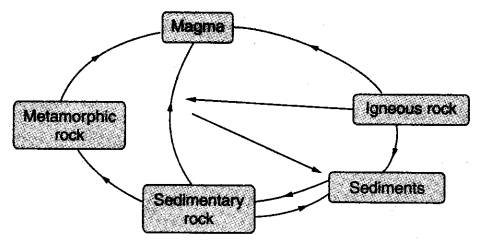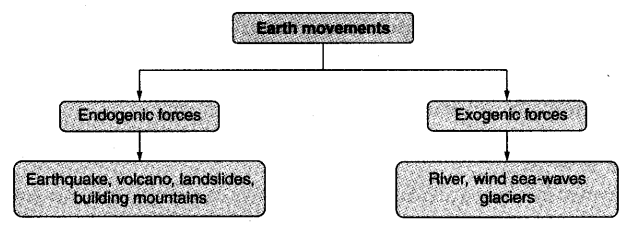Notes For All Chapters Geography Class 7
The lithosphere is broken down into a number of plates known as the Lithosphere plates.
The movement of these plates causes changes on the surface of the earth. The forces that act in the interior of the earth are called endogenic forces, while the forces that work on the surface of the earth are called exogenic forces.
Endogenic force causes earthquakes and volcanic eruptions.
Exogenic force causes weathering, erosion, deposition and gradation.
Weathering is the breaking up of the rocks on the earth’s crust.
Erosion is the breaking away of the landscape by different agents like water, wind and ice.
Sudden movements like earthquake and volcanoes cause most destruction over the surface of the earth.
A volcano is a vent (opening) in the earth’s crust through which molten material erupts suddenly.
The vibration in the plates of earth is called an earthquake.
The place in the crust where the movement starts is called the focus.
The place on the surface above the focus is called the epicenter.
It is measured by seismograph and intensity is measured by Richter scale.
Although earthquakes cannot be predicted, the impact can certainly be minimized.
Major Landforms
(i) The landscapes are continuously worn away by two forces, weathering and erosion.
(ii) Weathering is the breaking down of the rocks on the earth’s surface.
(iii) Erosion is the wearing away of the landscape by different agents like water, wind and ice.
Work of a River
(i) When the river tumbles at a steep angle over hard rocks or down a steep valley side, it forms a waterfall.
(ii) As the river enters the plain, it twists and turns, forming large bends known as meanders.
(iii) At this point of time, the meander loop cuts off from the river and forms a cut-off called an ox-bow lake.
(iv) During flooding, the river deposits layer of fine soil and other materials called sediments along its banks. This leads to the formation of a flat fertile plain called flood plain.
(v) The raised banks along the river are called levees.
(vi) The collection of sediments from all the mouths forms a delta.
Work of Sea Waves
(i) The erosion and deposition of the sea waves give rise to coastal landforms.
(ii) Due to sea waves, hollow caves are formed on the rocks. They are called sea caves.
(iii) As cavities become bigger in size, only the roof of the caves remains, thus forming sea arches.
(iv) The erosion further breaks the roof and only walls are left. It is called stacks.
(v) The steep rocky coast rising almost vertically above seawater is called sea cliff.
Work of Ice
(i) Glaciers are rivers of ice which erode the landscape by bulldozing soil and stones to expose the solid rocks below.
(ii) The material carried by the glaciers, such as big and small rocks, sand and silt get deposited. These deposits form glacial moraines.
Work of Winds
(i) An active agent of erosion and deposition in the deserts is wind. It makes rocks in shape of a mushroom, called mushroom rocks.
(ii) When the wind stops blowing, the sand falls and get deposited in low hill-like structures. These are called sand dunes.
(iii) When the grains of sand is very fine and light, the wind can carry it over long distances. When such sand is deposited in large areas, it is called loess.
The lithosphere is broken into numerous plates known as the lithospheric plates. These plates move around very slowly. The movement of these plates causes changes on the surface of the earth.
The earth movements are divided on the basis of the forces which cause them.
The forces which act in the interior of the earth are known as endogenic forces.
The forces which work on the surface of the earth are called as exogenic forces.
Endogenic forces sometimes produce sudden movements which cause earthquakes and volcanoes.
A volcano is an opening in the earth’s crust through which molten material erupts suddenly.
When the lithospheric plates move, the surface of the earth vibrates. The vibrations can travel all round the earth. These vibrations are known as earthquakes.
The place in the crust where the movement starts is known as the focus.
The epicentre of the earthquake is the place on the surface above the focus.
Maximum damage occurs near the epicentre.
Some common earthquake prediction methods include studying animal behaviour, fish in the ponds get agitated, snakes come to the surface.
The damage caused due to earthquakes can be minimised if we are prepared beforehand.
During an earthquake, one can take shelter under a kitchen counter, table or desk, against an inside corner or wall. One should be away from fireplaces, areas around chimneys, windows, etc.
Weathering and erosion are two processes due to which the landscape is being continuously worn away.
Weathering is the breaking up of the rocks on the earth’s surface. Erosion is the wearing ‘ away of the landscape by different agents like water, wind, etc.
When the river tumbles at a steep angle over very hard rocks or down a steep valley side it forms a waterfall.
Large bends formed by twisting and turning of the river while entering the plain are called meanders.
An oxbow lake is a cut-off lake formed due to cut off of a meander loop.
Flood plains are fertile areas formed by the deposition of fine soil and other material (sediments) during floods.
Levees are the raised banks of the rivers.
The streams which distribute the waters of a river are known as distributaries.
The triangular deposits at the mouth of a river from the delta, which is very fertile.
The erosion and deposition of the sea waves give rise to coastal landforms.
Hallow like caves are formed on the rocks at the coast due to erosional work of sea waves. These formations are called sea caves. When these cavities become very big, only the roof of the caves remains, forming sea arches.
This roof sometimes breaks due to erosion and thus only walls are left. These wall-like features are known as stacks.
The steep rocky coast rising almost vertically above seawater is called sea cliff.
The sea waves deposit sediments along the shores forming beaches.
The landscape is eroded due to glaciers which are rivers of ice. The material carried by the glacier such as rocks, sand and silt gets deposited and forms glacial moraines.
The wind is an active agent of erosion and deposition in the deserts. When the wind blows, it lifts and transports said from one place to another. When it stops blowing the sand falls and gets deposited in low hill-like structures known as sand dunes.
When very fine and light and gets deposited in large areas, it called loess.
Endogenic forces: The forces that act in the interior of the earth are called endogenic forces.
Exogenic forces: The forces that act on the surface of the earth are called as exogenic forces.
Earthquake: The vibrations caused by the movement of the lithospheric plates are called earthquakes.
Focus: The place in the crust where the movement starts is called the focus.
Epicentre: The place on the surface above the focus is called the epicentre.
Weathering: The breaking up of the rocks on the earth’s surface is known as weathering.
Erosion: The wearing away of the landscape by different agents like water, wind and ice is called erosion.
Waterfall: A place where a river or stream fails from a high place for example over a cliff or rock is known as waterfall.
Meander: Large bends formed by the twisting and turning of a river while entering a plain are known as meanders.
Floodplains: Floodplains are areas where fine soil and other material get deposited during floods. These are very fertile.
Levees: The raised banks of a river is known as levees.
Distributary: As the river approaches the sea, the speed of the flowing water decreases and the river begins to break up into a number of streams called distributaries.
Delta: It is a triangular area of land where a river has split into many smaller rivers before entering the sea.
Sea caves: Sea caves are hollow like caves formed on the rocks.
Sea arches: When the cavities become very big, only the roof of the caves remains known as sea arches.
Stacks: Further erosion breaks the roof and only wall-like features remain. These features are called stacks.
Seacliff: The steep rocky coast rising almost vertically above seawater is called sea cliff.
Beaches: The sea waves deposit sediments along the shores to form beaches.
Mushroom rocks: In deserts, rocks in the shape of a mushroom are very common. These are called mushroom rocks.
Sand dunes: In deserts, when the winds stop blowing, the sand falls and gets deposited in low hill-like structures known as sand dunes.
Loess: When very fine and light grains of sand gets deposited in large areas, it is called loess.


Leave a Reply